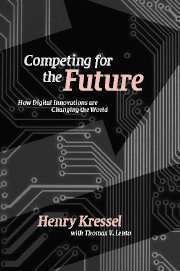Book contents
- Frontmatter
- Contents
- List of figures
- List of tables
- Acknowledgements
- Introduction
- Part I The technology – how electronic devices work – digital systems and software
- Part II Innovators, entrepreneurs, and venture capitalists
- Part III Global reach, global repercussions
- Appendix 1.1 Smaller, faster, more efficient MOSFETs
- Appendix 1.2 Building multi-transistor logic gates
- Appendix 1.3 MOSFETs in memory devices
- Appendix 1.4 CMOS reduces logic gate power dissipation
- Appendix 1.5 Laser diode basics
- Appendix 1.6 Light-emitting diodes (LEDs)
- Appendix 1.7 Photodetectors
- Appendix 1.8 Making fiber optic cables
- Appendix 1.9 Principles of LCD displays
- Appendix 2.1 The demise of analog computers
- Appendix 2.2 IP, TCP, and the Internet
- Appendix 2.3 Building an object-oriented program
- Index
Appendix 2.3 - Building an object-oriented program
Published online by Cambridge University Press: 07 December 2009
- Frontmatter
- Contents
- List of figures
- List of tables
- Acknowledgements
- Introduction
- Part I The technology – how electronic devices work – digital systems and software
- Part II Innovators, entrepreneurs, and venture capitalists
- Part III Global reach, global repercussions
- Appendix 1.1 Smaller, faster, more efficient MOSFETs
- Appendix 1.2 Building multi-transistor logic gates
- Appendix 1.3 MOSFETs in memory devices
- Appendix 1.4 CMOS reduces logic gate power dissipation
- Appendix 1.5 Laser diode basics
- Appendix 1.6 Light-emitting diodes (LEDs)
- Appendix 1.7 Photodetectors
- Appendix 1.8 Making fiber optic cables
- Appendix 1.9 Principles of LCD displays
- Appendix 2.1 The demise of analog computers
- Appendix 2.2 IP, TCP, and the Internet
- Appendix 2.3 Building an object-oriented program
- Index
Summary
To get a feel for object-oriented architectures, consider a very simple program designed to update the contents of a particular master file. Figure A-2.3.1 shows the “old” way of architecting such a program, by logical decomposition of the process into steps that are sequentially linked to produce the program. To produce this program, each element of the process must be coded in tightly-linked sequences.
By contrast, in the object-oriented architecture shown in Figure A-2.3.2, the program is divided into abstractions of the key elements. Instead of steps, the problem is now defined in terms of autonomous interconnected objects. Each object has its real-world mission defined, and is given its operational orders and required variables through the bus.
Program development using object-oriented technology can be divided into four interdependent elements.
The first critical task is the definition of program requirements. This requires close communication with the intended users and an understanding of their applications.
Program architecture is developed on the basis of these requirements. The skill of the architect determines the ultimate quality of the program and the time required to complete it.
The production of the program proceeds, with coding by programmers who write within tight guidelines provided by the program architects.
Finally, the completed program must be tested. Note that testing can account for between 40 and 50 percent of the cost of developing a large program.
Program definition and architecture require the most skilled and experienced people. These two steps produce virtually all of the program's intellectual property value.
- Type
- Chapter
- Information
- Competing for the FutureHow Digital Innovations are Changing the World, pp. 383 - 385Publisher: Cambridge University PressPrint publication year: 2007



